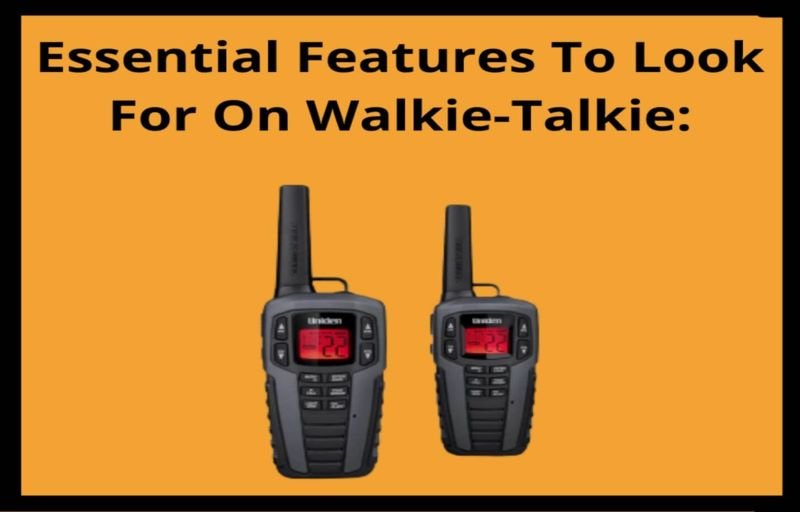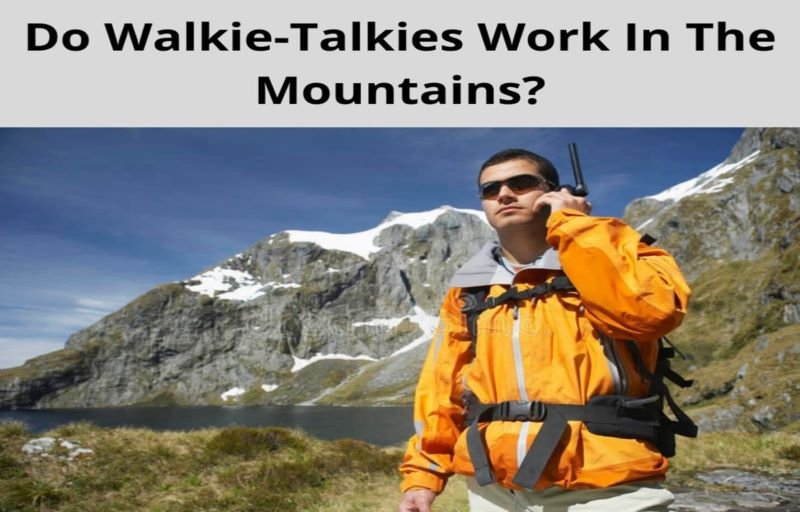Phone service may be spotty in the mountains, particularly in distant places. When mountaineering, many people rely on walkie-talkies and other simple communication gear. So, Best 2 Way Walkie-Talkies! Do They Work in the Mountains? This article will answer this question and present a simple guide on optimizing a walkie-talkie signal. Let’s begin!
.PS: Always Ask Your Government Communication Department if a Licence is Required for Your Model.
What’s a Two-Way Walkie-Talkie?
First and foremost, walkie-talkies resemble portable, screenless devices that function similarly to radios. They have the same frequency spectrum that allows for wireless communication. All walkie-talkies have a battery-operated transmitting unit and a receiving unit, respectively. Radio waves go from one branch to another through the antenna on top of each gadget.
The speakers on the front of the gadget usually also serve as a microphone, with a button to chat. When you initially turn it on, you’ll probably hear nothing but static until you hit the push-to-talk button and another person with the second device responds.
There are fancier walkie-talkies with various buttons for scanning channels; some will have a little screen to identify the track you’re on and other data.
Do The Best 2 Way Walkie-Talkies Work in the Mountains?
Walkie-talkies communicate via radio waves at a particular frequency. So, theoretically, they can function in almost any place where is a suitable medium for the waves to transmit.
However, the range of walkie-talkies varies depending on the model. They are also susceptible to signal degradation owing to barriers that reduce or block the route of the waves, such as thick trees, buildings, and other significant obstacles.
Radio waves generally do not go farther than the human eye can see. Therefore, if you can see it, you can also hear it.
Factors That Affect the Signal of Walkie-Talkie:

Now that you know that walkie-talkies can function in the mountains but can be restricted by specific circumstances. Take a moment to consider the following:
Walkie-Talkie Range:
The range and antenna of the device are significant limiting factors in walkie-talkie efficiency. However, some walkie-talkies are short-ranged, whereas others are long-ranged.
Walkie-talkies used in the mountains or other expansive areas must have an extended range of communication to be effective.
Location:
Because barriers are the most challenging hurdle for radio signals, your location in the mountain will influence the performance of your walkie-talkie. The walkie-talkie signal should be strong among two mountain summits or between a peak and base in an open area.
Environment:
Little rain may not affect a robust walkie-talkie’s signal, but blizzards in steep locations may. In addition, the radio’s internal components may be affected or damaged by the intense cold weather, rendering it useless.
Related Article: 6 Best Handheld Two Way Radios!
Ways To Improve the Signals of Walkie-Talkies:
1. Purchasing A Walkie-Talkie with Enhanced Signal Strength:
The strength of the signal is one of the most crucial aspects of effective walkie-talkie communication. Therefore, it’s essential to think about getting a walkie-talkie with stronger signals. Better communication may ensure using walkie-talkies that have a stronger signal.
As a result, obtaining a Walkie-Talkie with higher signal strength is the best method to assure better range. Consider employing a GMRS Walkie-Talkie since its range is more significant than FRS models.
2. Use A Signal Booster:
Signal boosters assist in improving the signal strength of walkie-talkies. It also helps to increase the range of the walkie-talkie, and it’s a powerful tool for facilitating communication.
It ensures that your voice may reach over a greater distance. As a result, a signal booster may use to extend the range of a walkie-talkie or two-way radio. Different kinds of signal boosters aid in increasing the span of a walkie-talkie.
You should evaluate elements like range, pricing, booster reviews, and much more when purchasing a signal booster. These aspects will assist you in selecting an excellent signal booster.
3. Analyze the Antenna System:
When you notice a decrease in signal strength on your walkie-talkie, you should check to see if the device’s antenna system is in good working order. Because the antenna significantly impacts the device’s range. Raising the antenna’s altitude, swapping for a longer antenna, etc., are all viable options for expanding the device’s reach.
4. Use Walkie-Talkie Batteries to Increase Power:
The battery capacity of various walkie-talkie devices varies substantially. For instance, the battery voltage of specific walkie-talkie devices is 3V, whereas that of others might be 6V. Thus, you must check the battery life of your walkie-talkie. The higher the amperage of your battery the better
Features To Look for When Buying Walkie-Talkie:
Walkie-talkies are fantastic for staying in contact while on an adventure, but you should understand why they work so well. So, before you buy a unit, make sure it has these qualities.
FRS (Family Radio Service):
This two-way radio has access to 22 channels in both the FRS and GMRS radio bands, allowing for a wide range of communication options. It means you can talk to other people using radios on the same frequency as you, which helps find immediate assistance. You also have 121 privacy codes at your disposal to safeguard your connection.
FRS is the most often used system in our walkie-talkies. Using this readily remembered frequency, you may quickly and easily contact your loved ones no matter where they may be on the grounds.
Range:
When you need a trusted buddy on your trip, two-way radio communication is a crucial element to consider. The range that a given product provides will, of course, change based on factors like the location, the strength of the signal, and the size of the obstruction.
Battery:
Up in the mountains, there isn’t precisely a charging hub for your device. Therefore, battery life of at least 10 hours, preferably longer, would be helpful.
It’s also a good idea to have some additional rechargeable batteries for your walkie-talkie in an emergency. Radios with a signal boosting feature will decrease the battery much faster than standard models, so keep that in mind when packing.
NOAA Weather Channels:
The National Oceanic and Atmospheric Administration (NOAA) is a branch of the United States government to prevent further damage to ecosystems, weather systems, etc. NOAA radio receives National Weather Service (NWS) broadcasts on storms and tsunamis 24 hours a day, seven days a week.
You never know what may happen up in the mountains. It is a highly unexpected location, and you must be prepared for everything.
Channel Scan:
It might be a pain if you don’t recall which channel, you last used, but there is an easy fix. Activate the scan button and let it go over all available media, pausing when activity is detected.

Noise Filter – Clarity:
Think about the range and clarity of the walkie-talkie you’re interested in purchasing. FRS has better clarity over shorter distances, while GMRS has better clarity over longer distances, but which do you prefer? A gadget with the enhanced sound quality for near encounters or one that works effectively over extended distances.
Though most products advertise a more excellent range, such as 30 miles, the reality is somewhat different. Some of the best walkie-talkies will provide incredible clarity for a distance of 2 miles in the mountains. However, most walkie-talkies have a range of one mile in forest and mountain environments.
Antenna Strength:
Pack a robust but lightweight antenna for your trip up the mountain. It may affect the strength of your signal and the performance of your radio. And some mountain walkie-talkies include a removable antenna that may be reattached or replaced with a better choice if the need arises.
Waterproof:
A good radio should be waterproof and robust enough to withstand impact shock. This device’s use in saving lives also necessitates its resilience to rain or other severe environments. Finally, its rigid construction can endure any test by Mother Nature herself. A waterproof walkie-talkie could make the difference between life and death in an emergency.
Hands-Free mode:
Many two-way radios may be programmed to broadcast as you talk without using the PTT (Push to Talk) button. This mode is called Voice Operated Transmission (VOX).
This feature is ideal for sports that need both hands, such as skiing or climbing. It allows for clear communication thanks to their headset, which often comes with a unit.
Power-Saving Features:
If you’re in the wilderness, saving your battery is critical to stay connected for as long as possible. You may implement an automated power-off function to save energy further. A built-in timer ensures that the device turns off and stops transmitting after a certain time has passed to protect power.
Its battery conservation mode is also known as low power mode or sleep. It helps to increase the life of your batteries by turning them off entirely when not in use for a lengthy period to conserve energy. It requires manual activation through the device’s settings and deactivation to turn off permanently.
Buying Guide of a Walkie-Talkie for Mountains:
The Number of Handsets Required:
Suppose you are traveling with a group of business colleagues, friends, or family. In that case, you may consider getting numerous walkie-talkies that come in a single bundle.
You would save money by not having to buy individual units for each member.
Choose VHF Over UHF:
VHF radios have a better range than UHF radios. You’ll need the maximum range in the mountains, especially if you or someone else gets lost. It’s also helpful in calling further-away emergency services.
It is also vital to understand that VHF radios cannot normally connect with UHF radios. As a result, be sure that all the radios you buy have the same frequency. It is another reason it’s a good idea to buy a package that includes several walkie-talkies.
Isolation:
The distance between you and any town is an essential factor. Your kit would contain adequate food, beverages, and other necessities. You should also consider the number of spare batteries you will need. To be safe, bring two extra battery packs, ideally AA batteries that do not need to be charged before use.
Additional Resources
If you are looking for more tutorials, walkthroughs and troubleshooting about camping and enjoying the outdoors, here are some additional posts to check out:
Conclusion:
Yes, that’s it! A practical guide on using walkie-talkies and two-way radios in the mountains. While walkie-talkies function adequately, they are frequently restricted to obstacles and conditions that diminish the signal.
As a result, it’s critical to use the walkie-talkie in a clear area and with a dependable model for enhanced efficiency! If you want to know more about the best two-way radios, you can read my review and buying guide on “6 Best Handheld Two Way Radios!” If you think I forget something or if you simply want to share a story, feel free to leave a comment below, but for now… Be Safe and Have Fun.!

